A bit of movie magic is happening in an abandoned church at the center of what was once a thriving industrial town.
A set designer pins white lace curtains up over the windowless frames of an old classroom, then kneels in the rubble-strewn floor to melt the tops of some candles with a blowtorch.
Crew members beat a path through the dirt on a rusty stairwell as pigeons flutter through gaping holes in the roof to their roosts.
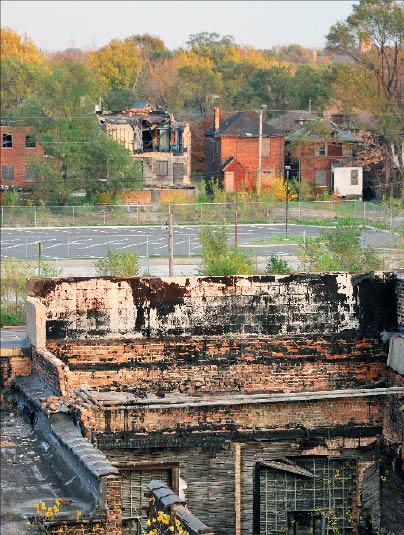
Photo: AFP
It is the perfect setting for a spooky thriller about a serial killer, Altered director Kely McClung says.
“One of my rules for making low-budget films look rich and expensive is rust, dust and dirt. It films beautifully and it helps tell our story as well,” McClung says.
Gary, Indiana, has rust, dust and dirt to spare.
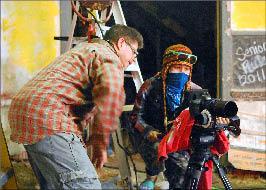
Photo: AFP
BOOM TIMES
Founded by the US Steel Corporation on the shores of Lake Michigan just across the state line from Chicago in 1906, the story of Gary’s meteoric rise and fall is one shared by industrial towns across the nation. The steel boom brought tens of thousands of good jobs and a can-do spirit that was serenaded in the 1957 musical The Music Man, with the feel-good tune Gary, Indiana.
However, life got bad in a hurry when the steel industry suffered a sudden collapse in the 1970s, exacerbating white flight to the suburbs.
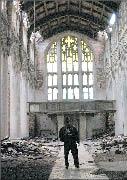
Photo: AFP
Countless civic efforts have failed to stop the downward spiral. Gary’s population has fallen from a peak of 178,000 in 1960 to just 80,000 today. It is riddled with poverty, violence and crime.
PICTURE PERFECT
A Hollywood film crew couldn’t design a more convincing set for urban decay if they tried.
The main drag is a ghost of Gary’s former glory, with nearly every shop boarded up, except the usurious payday loan office. Someone tried to add a little cheer by painting a smiling usher on the boards covering up the ticket booth of the movie theater. He is amazingly free of graffiti, perhaps because the few remaining neighborhood kids have so many more enticing ways to make trouble.
Tourists searching for “King of Pop” Michael Jackson’s birthplace on 2300 Jackson Street turn west off Broadway and drive past empty streets lined with crumbling homes marred by fire, wind and neglect.
Dilapidated factories stripped long ago by scavengers squat behind rusted fences a few blocks away.
On the lakefront, smoke billows out of the stacks at US Steel and gas flares light up the night sky.
With its shrunken tax base, Gary cannot afford to demolish its thousands of abandoned buildings.
Ben Clement — a former television show host who moved home from Ohio to try to revitalize Gary and ended up as the head of its economic development office — decided it was time the city got some use out of them.
He founded the Gary Office of Film and Television in 1997 and has brought hundreds of crews to town.
“Since these buildings are here anyway and since they have a certain esoteric or aesthetic quality to them that is very attractive to filmmakers, why not take these lemons and in essence make lemonade,” Clement says.
STAR ATTRACTION
The gothic City Methodist Church, which has been abandoned for about 30 years, has been used in at least 75 projects, including Transformers 3, Nightmare on Elm Street and a gospel music video.
McClung, who camped out in the church to guard his equipment during early shoots and has since rented an apartment a few blocks away, says the city has bent over backwards to help him. He’s already planning other projects here.
“There are a lot of stories that could be told in these buildings,” he says.
“It’s not just this church. There’s train stations and hospitals and auditoriums and factories and houses, and it just goes on and on,” he says.
FINANCIAL GAINS
The economic impact of film projects in Gary is unclear. Some locals have been hired as extras and a handful even managed to get coveted union cards after landing acting roles and crew jobs.
However, without nearby restaurants, shops and hotels most of the money movie crews bring gets spent in neighboring towns.
Gary keeps the fee structure quite “user friendly” — US$500 a day per location for feature films, US$250 a day for independent shorts and US$50 a day for student films — so the impact on city revenues is modest, Clement says.
CREATIVE FIRE
There’s more to it, though, than just dollars and cents. Gary now has a burgeoning local arts scene and hosted its first film festival in February. And then there’s the emotional boost for a town where good news is often hard to come by.
“We had literally thousands of people behind a rope watching Transformers being filmed,” Clement says. “Who knows what spark was created in those children’s imagination?”
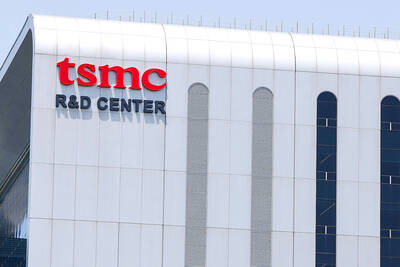
BIG BUCKS: Chairman Wei is expected to receive NT$34.12 million on a proposed NT$5 cash dividend plan, while the National Development Fund would get NT$8.27 billion Taiwan Semiconductor Manufacturing Co (TSMC, 台積電), the world’s largest contract chipmaker, yesterday announced that its board of directors approved US$15.25 billion in capital appropriations for long-term expansion to meet growing demand. The funds are to be used for installing advanced technology and packaging capacity, expanding mature and specialty technology, and constructing fabs with facility systems, TSMC said in a statement. The board also approved a proposal to distribute a NT$5 cash dividend per share, based on first-quarter earnings per share of NT$13.94, it said. That surpasses the NT$4.50 dividend for the fourth quarter of last year. TSMC has said that while it is eager

‘IMMENSE SWAY’: The top 50 companies, based on market cap, shape everything from technology to consumer trends, advisory firm Visual Capitalist said Taiwan Semiconductor Manufacturing Co (TSMC, 台積電) was ranked the 10th-most valuable company globally this year, market information advisory firm Visual Capitalist said. TSMC sat on a market cap of about US$915 billion as of Monday last week, making it the 10th-most valuable company in the world and No. 1 in Asia, the publisher said in its “50 Most Valuable Companies in the World” list. Visual Capitalist described TSMC as the world’s largest dedicated semiconductor foundry operator that rolls out chips for major tech names such as US consumer electronics brand Apple Inc, and artificial intelligence (AI) chip designers Nvidia Corp and Advanced
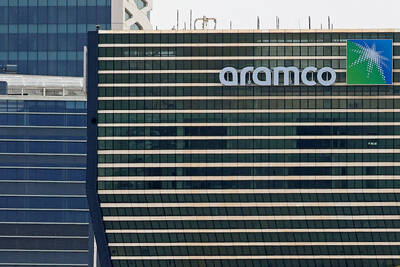
Saudi Arabian Oil Co (Aramco), the Saudi state-owned oil giant, yesterday posted first-quarter profits of US$26 billion, down 4.6 percent from the prior year as falling global oil prices undermine the kingdom’s multitrillion-dollar development plans. Aramco had revenues of US$108.1 billion over the quarter, the company reported in a filing on Riyadh’s Tadawul stock exchange. The company saw US$107.2 billion in revenues and profits of US$27.2 billion for the same period last year. Saudi Arabia has promised to invest US$600 billion in the US over the course of US President Donald Trump’s second term. Trump, who is set to touch
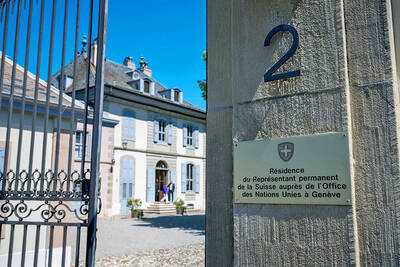
SKEPTICAL: An economist said it is possible US and Chinese officials would walk away from the meeting saying talks were productive, without reducing tariffs at all US President Donald Trump hailed a “total reset” in US-China trade relations, ahead of a second day of talks yesterday between top officials from Washington and Beijing aimed at de-escalating trade tensions sparked by his aggressive tariff rollout. In a Truth Social post early yesterday, Trump praised the “very good” discussions and deemed them “a total reset negotiated in a friendly, but constructive, manner.” The second day of closed-door meetings between US Secretary of the Treasury Scott Bessent, US Trade Representative Jamieson Greer and Chinese Vice Premier He Lifeng (何立峰) were due to restart yesterday morning, said a person familiar